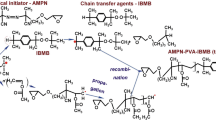Abstract
The conducting film material intended for research in the field of cell technology is obtained on the basis of two biocompatible polymers—aliphatic copolyamide and polypyrrole. The material consists of hybrid nanofibers having the core–shell structure. The film is formed by copolyamide microfibers that are obtained by electrospinning and coated with a polypyrrole nanolayer. Studies show that the material is stable and does not change its characteristics when stored both in air and in aqueous media. The hybrid fiber film has a high porosity, good water wettability, and a sufficient level of stress–strain characteristics. The resistance of the material is 300–600 Ω/sq, which allows its use for the electrical stimulation of proliferative activity of cells.



Similar content being viewed by others
REFERENCES
G. Kaur, R. Adhikari, P. Cass, M. Bown, and P. Gunatillake, RSC Adv. 5, 37553 (2015).
J. R. Smith and D. A. Lamprou, Trans. IMF 92, 9 (2014).
J. Quirós, K. Boltes, and R. Rosal, Polym. Rev. 56, 631 (2016).
M. P. Prabhakaran, L. Ghasemi-Mobarakeh, and S. Ramakrishna, J. Nanosci. Nanotechnol. 11, 3039 (2011).
F. Sheikha, J. Macossaya, T. Cantua, X. Zhanga, M. S. Hassanc, M. E. Salinasa, C. S. Farhangia, H. Ahmada, H. Kimd, and G. L. Bowline, J. Mech. Behav. Biomed. Mater. 4, 189 (2015).
S. Liu, J. Wang, D. Zhang, P. Zhang, J. Oua, B. Liu, and S. Yang, Appl. Surf. Sci. 256, 3427 (2010).
V. Guarino, S. Zuppolini, A. Borriello, and L. Ambrosio, Polymers 8, 185 (2016).
X. Wang, X. Gu, C. Yuan, S. Chen, P. Zhang, and T. Zhang, J. Biomed. Mater. Res., Part A 68, 411 (2004).
I. Yu. Sapurina, M. E. Kompan, A. G. Zabrodskii, J. Stejskal, and M. Trchova, Russ. J. Electrochem. 43, 528 (2007).
C. Yang, X. Wang, Y. Wang, and P. Liu, Powder Technol. 217, 134 (2012).
M. E. Abdelhamid, A. P. O’Mullane, and G. A. Snook, RSC Adv. 5, 11611 (2015).
J. Rodriges, H. Grande, T. F. Otero, T. Trigaud, and J. P. Molion, Synth. Met. 83, 201 (1996).
C. S. Park, C. Lee, and O. S. Kwon, Polymers 8, 249 (2016).
T. F. Otero, J. G. Martinez, and J. Arias-Pardilla, Electrochim. Acta 84, 112 (2012).
A.-D. Bendrea, L. Cianga, and I. Cianga, J. Biomater. Appl. 26, 3 (2011).
L. Marquardt and S. E. Sakiyama-Elbert, Curr. Opin. Biotechnol. 24, 887 (2013).
J. Xie, M. R. MacEwan, St. M. Willerth, X. Li, D. W. Moran, S. E. Sakiyama-Elbert, and Y. Xia, Adv. Funct. Mater. 19, 2312 (2009).
V. Lundin, A. Herland, M. Berggren, E. W. H. Jager, and A. I. Teixeira, PLoS One 6, e18624 (2011).
Z. Cui, B. Yang, and R.-K. Li, Engineering 2, 141 (2016).
Z.-B. Huang, G.-F. Yin, X.-M. Liao, and J.-W. Gu, Front. Mater. Sci. 8, 39 (2014).
D. L. Francisco, L. B. Paiva, and A. Wagner, Polym. Compos. 40, 851 (2019).
I. P. Dobrovolskaya, P. V. Popryadukhin, V. E. Yudin, E. N. Dresvyanina, E. M. Ivan’kova, I. V. Gofman, and C. V. Kononova, Russ. J. Appl. Chem. 84, 1795 (2011).
G. Kang, R. B. Borgens, and Y. Cho, Langmuir 27, 6179 (2011).
I. P. Dobrovolskaya, I. O. Lebedeva, V. E. Yudin, P. V. Popryadukhin, E. M. Ivan’kova, and V. Yu. Elokhovskii, Polym. Sci., Ser. A 58, 246 (2016).
I. P. Dobrovolskaya, P. V. Popryadukhin, P. V. Yudin, E. M. Ivan’kova, V. Yu. Elokhovskiy, Z. Weishauptova, and K. Balik, J. Mater. Sci.: Mater. Med. 26, 538 (2015).
V. V. Matrenichev, M. A. Shishov, and P. V. Popryadukhin, I. Yu. Sapurina, E. M. Ivan’kova, I. P. Dobrovolskaya, and V. E. Yudin, Russ. J. Appl. Chem. 90, 1680 (2017).
P. V. Popryadukhin, G. I. Popov, I. P. Dobrovolskaya, and V. E. Yudin, Cardiovasc. Eng. Technol. 7, 78 (2015).
M. Yanılmaz and S. A. Sezai, Text. Res. J. 84, 1325 (2014).
I. S. Chronakis, S. Grapenson, and A. Jakob, Polymer 47, 1597 (2006).
S. Sen, F. J. Davis, and G. R. Mitchell, J. Phys.: Conf. Ser. 183, 012020 (2009).
M. Yanilmaz, F. Kalaoglu, and H. Karakas, J. Appl. Polym. Sci. 125, 4100 (2012).
B. Guo and P. X. Ma, Biomacromolecules 19, 1764 (2018).
S. Nair, E. Hsiao, and S. H. Kim, J. Mater. Chem. 18, 5155 (2008).
I. Sapurina, S. Fedorova, and J. Stejskal, Langmuir 19, 7413 (2003).
J. Kopecka, D. Kopecky, M. Vrnata, P. Fitl, J. Stejskal, M. Trchova, P. Bober, Z. Moravkova, J. Prokes, and I. Sapurina, RSC Adv. 4, 1551 (2014).
I. Sapurina, Y. Li, E. Alekseeva, P. Bober, M. Trchova, Z. Moravkova, and J. Stejskal, Polymer 113, 247 (2017).
B. N. Tarasevich, Reference Materials. IR Spectra of Main Classes of Organic Compounds (MGU, Khim. Fakul’tet, Kafedra Org. Khim., Moscow, 2012) [in Russian].
R. M. Silverstein, F. X. Webster, and D. J. Kiemle, Spectrometric Identification of Organic Compounds (Wiley, New Jersey, 2005).
M. A. Shougule, S. G. Pawara, P. R. Godsea, N. R. Mulika, S. Senb, and V. B. Putila, Soft Nanosci. Lett. 1, 6 (2011).
J.-Y. Liu, C. Kou-Bing, J.-F. Hwang, J.-Y. Liu, C. Kou-Bing, J. F. Hwang, and M. H. Lee, J. Ind. Text. 41, 123 (2011).
B. Hernández-Gascón, E. Peña, and H. Melero, Acta Biomater. 7, 3905 (2011).
I. Sapurina, J. Stejskal, M. Spirkova, J. Kotek, and J. Prokes, Synth. Met. 151, 93 (2005).
Funding
This study was supported by the Russian Science Foundation (project no. 19-73-30003).
Author information
Authors and Affiliations
Corresponding author
Rights and permissions
About this article
Cite this article
Sapurina, I.Y., Matrenichev, V.V., Vlasova, E.N. et al. Synthesis and Properties of a Conducting Material Based on Hybrid Nanofibers of Aliphatic Copolyamide and Polypyrrole. Polym. Sci. Ser. B 62, 116–124 (2020). https://doi.org/10.1134/S156009042001008X
Received:
Revised:
Accepted:
Published:
Issue Date:
DOI: https://doi.org/10.1134/S156009042001008X



